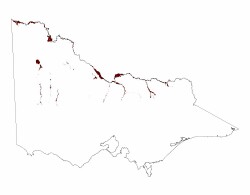4.1.1 Meander belt below plain level, sometimes source-bordering dunes (Mooroopna, Wangaratta)
4. Northern Riverine Plain (RP)
4.1 - Modern floodplains
| The modern alluvial terraces and floodplains of today’s active rivers carry young soils of varied texture and have been described as the late Quaternary Coonambidgal Formation (Lawrence, 1966). Source-bordering dunes are found along these channels, generally on their northeastern sides. Several former but young courses of major rivers such as the Murray and Goulburn are marked by inset terraces and extensive flood-plain meander belts with scrolls and oxbow lakes, as at Mooroopna and Wangaratta. This grouping of geomorphological units describes the (generally) youngest spatial landscape features; the current floodplain of major streams. These units are generally incised into an alluvial plain (4.2) with or without terraces. They are defined as being un-confined in the sense that they are not surrounded by upland and formed on alluvial material (Coonambidgal Formation), part of the most recent alluvial landform complex. |  |
The Wimmera River floodplain is the major unit with a number of effluent streams with confined floodplains such as Yarriambiack Creek and Dunnmunkle Creek. The floodplain is more obviously unconfined downstream of Glenorchy and diverted north-west adjacent to Grampians outwash material (4.3), then aligned east/west before sharply turning north and being confined within the Lowan Salt Valley and masked by the Little Desert (5.2) just south of Dimboola. The floodplain terminates at Lake Hindmarsh where it is surrounded by predominantly calcareous plains and dunes. A channel with minor floodplain connects Lake Hindmarsh to Lake Albacutya. This floodplain is minor and intermittent amongst the calcareous dunes and plains (5.1) and the siliceous dunes and plains of the Big Desert (5.2). There are some other meanders in the mid Wimmera tract, particularly where tributary streams such as Mt William Creek confluence. Drainage across the plains varies from annabranching streams to meandering channels in form with slopes very gentle to gently inclined. Soil-landform units are relatively slender (generally less than 2 km across) and contain entirety of the Wimmera River and Yarriambiack Creek within its extent.
Soils vary on the young unconsolidated regolith from sands, loams to clays where finer material has accumulated. There is a higher alkaline component (sodium and calcium) north of Quantong. Major soils include sodic, grey texture contrast soils (grey Sodosols) and cracking clay soils (Vertosols).
The texture contrast soils have slightly acidic sandy clay loam surfaces over grey light clays that increase in sodicity with depth. Minor carbonate occurs in the subsoil. The cracking clays are acidic at the surface with light clays clearly changing to heavy clay subsoils that can be more acidic at depth and very few carbonate nodules. Depths for all soils are generally in excess of 2 metres.
Vegetation may also change with climate (drier to the north) though Red Gums are a major overstorey species.Vegetation communities along these floodplains include a variety of woodlands including Plains Woodland, Drainage-line Woodland, Salt Paperbark Woodland, Lignum Swampy Woodland, Riparian Woodland, Creekline Sedgy Woodland and Riverine Chenopod Woodland for example.
Flooding provides a significant hazard for this unit especially in urban areas along the rivers and creeks. Shrink-swell behaviour of cracking clays around these urban areas may also be a relevant factor in residential development and selection of footings that will accommodate clay expansion and contraction.


